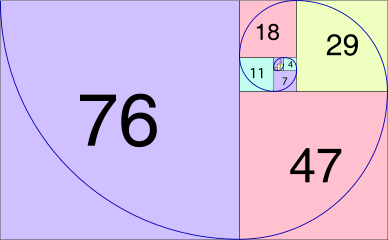Lucas number

The Lucas numbers or Lucas series are an integer sequence named after the mathematician François Édouard Anatole Lucas (1842–91), who studied both that sequence and the closely related Fibonacci numbers. Lucas numbers and Fibonacci numbers form complementary instances of Lucas sequences.
The Lucas sequence has the same recursive relationship as the Fibonacci sequence, where each term is the sum of the two previous terms, but with different starting values. This produces a sequence where the ratios of successive terms approach the golden ratio, and in fact the terms themselves are roundings of integer powers of the golden ratio.[1] The sequence also has a variety of relationships with the Fibonacci numbers, like the fact that adding any two Fibonacci numbers two terms apart in the Fibonacci sequence results in the Lucas number in between.[2]
Definition
Similar to the Fibonacci numbers, each Lucas number is defined to be the sum of its two immediate previous terms, thereby forming a Fibonacci integer sequence. The first two Lucas numbers are L0 = 2 and L1 = 1 as opposed to the first two Fibonacci numbers F0 = 0 and F1 = 1. Though closely related in definition, Lucas and Fibonacci numbers exhibit distinct properties.
The Lucas numbers may thus be defined as follows:
(where n belongs to the natural numbers)
The sequence of Lucas numbers is:
All Fibonacci-like integer sequences appear in shifted form as a row of the Wythoff array; the Fibonacci sequence itself is the first row and the Lucas sequence is the second row. Also like all Fibonacci-like integer sequences, the ratio between two consecutive Lucas numbers converges to the golden ratio.
Extension to negative integers
Using Ln−2 = Ln − Ln−1, one can extend the Lucas numbers to negative integers to obtain a doubly infinite sequence:
- ..., −11, 7, −4, 3, −1, 2, 1, 3, 4, 7, 11, ... (terms for are shown).
The formula for terms with negative indices in this sequence is
Relationship to Fibonacci numbers

The Lucas numbers are related to the Fibonacci numbers by the identities
- , and thus as approaches +∞, the ratio approaches
Their closed formula is given as:
where is the golden ratio. Alternatively, as for the magnitude of the term is less than 1/2, is the closest integer to or, equivalently, the integer part of , also written as .
Combining the above with Binet's formula,
a formula for is obtained:
Congruence relations
If Fn ≥ 5 is a Fibonacci number then no Lucas number is divisible by Fn.
Ln is congruent to 1 mod n if n is prime, but some composite values of n also have this property. These are the Bruckman-Lucas pseudoprimes.
Lucas primes
A Lucas prime is a Lucas number that is prime. The first few Lucas primes are
- 2, 3, 7, 11, 29, 47, 199, 521, 2207, 3571, 9349, 3010349, 54018521, 370248451, 6643838879, ... (sequence A005479 in the OEIS).
For these ns are
- 0, 2, 4, 5, 7, 8, 11, 13, 16, 17, 19, 31, 37, 41, 47, 53, 61, 71, 79, 113, 313, 353, 503, 613, 617, 863, 1097, 1361, 4787, 4793, 5851, 7741, 8467, ... (sequence A001606 in the OEIS).
If Ln is prime then n is either 0, prime, or a power of 2.[3] L2m is prime for m = 1, 2, 3, and 4 and no other known values of m.
Generating series
Let
be the generating series of the Lucas numbers. By a direct computation,
which can be rearranged as
The partial fraction decomposition is given by
where is the golden ratio and is its conjugate.
Lucas polynomials
In the same way as Fibonacci polynomials are derived from the Fibonacci numbers, the Lucas polynomials Ln(x) are a polynomial sequence derived from the Lucas numbers.
See also
References
- ↑ Parker, Matt (2014). "13". Things to Make and Do in the Fourth Dimension. Farrar, Straus and Giroux. p. 284. ISBN 978-0-374-53563-6.
- ↑ Parker, Matt (2014). "13". Things to Make and Do in the Fourth Dimension. Farrar, Straus and Giroux. p. 282. ISBN 978-0-374-53563-6.
- ↑ Chris Caldwell, "The Prime Glossary: Lucas prime" from The Prime Pages.
External links
- Hazewinkel, Michiel, ed. (2001) [1994], "Lucas polynomials", Encyclopedia of Mathematics, Springer Science+Business Media B.V. / Kluwer Academic Publishers, ISBN 978-1-55608-010-4
- Weisstein, Eric W. "Lucas Number". MathWorld.
- Weisstein, Eric W. "Lucas Polynomial". MathWorld.
- Dr Ron Knott
- Lucas numbers and the Golden Section
- A Lucas Number Calculator can be found here.
- OEIS sequence A000032 (Lucas numbers beginning at 2)